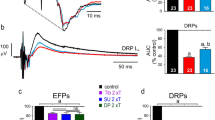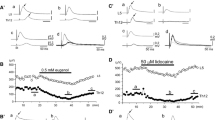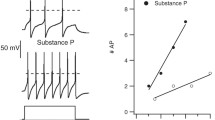Abstract
Effects of dopamine on dorsal root potentials were investigated during experiments on a segment of spinal cord isolated from 12- to 18-day-old rats. Applying dopamine to the brain was found to produce a slow, reversible, dose-dependent depolarization at primary afferent fiber terminals. This dopamine-induced depolarization was retained during complete blockade of synaptic transmission brought about by exchanging calcium ions in the perfusing fluid by magnesium or manganese ions. Minimum dopamine concentration required to produce this effect was 1·10−10–1·10−9 M. Peak amplitude of depolarization equaled 1.5 mV. Duration of this reaction ranged from 5.5 to 36.7 min, depending on the duration and concentration of dopamine application. Depolarizing response to dopamine differed considerably from GABA-induced dorsal root depolarization in amplitude and rate of rise. Haloperidol, a dopamine antagonist, reduced dopamine-induced dorsal root depolarization. Findings indicate that dopamine acts directly on the membrane of primary afferent fiber terminals, shifting membrane potential toward depolarization. This raises the possibility that dopaminergic brainstem-spinal pathways may exert an effect on sensory information transmission in segmental reflex arcs already traveling to the spinal cord.
Similar content being viewed by others
Literature cited
V. N. Oksamitnyi and Z. A. Tamarova, "Inhibitory action of dopamine on transmission of excitation in isolated rat spinal cord," Neirofiziologiya,18, No. 5, 616–621 (1986).
V. N. Oksamitnyi and Z. A. Tamarova, "Depolarizing action of dopamine on motoneurons in segments of spinal cord isolated from newborn rats," Neirofiziologiya,19, No. 6, 735–541 (1987).
F. N. Serkov, N. Z. Doroshenko, and V. A. Maiskii, "Retrogradely primuline-labeled dopamine-containing neurons as sources of descending supraspinal fibers in the rat spinal cord," Dokl. Akad. Nauk SSSR,292, No. 6, 1506–1509 (1987).
W. W. Blessing and J. P. Chalmers, "Direct projection of catecholamine (presumably dopamine)-containing neurons from hypothalamus to spinal cord," Neurosci. Lett.,11, No. 1, 35–40 (1979).
J. W. Commisiong and N. H. Neff, "Current status of dopamine in the mammalian spinal cord," Biochem. Pharmacol.,28, No. 10, 1569–1573 (1979).
P. Demenge, P. Mouchet, B. Guerin, and C. Fenerstein, "Identification and distribution of neuroleptic binding sites in the rat spinal cord," J. Neurochem.,37, No. 1, 53–59 (1981).
J. P. Gallagher, H. Inokuchi, and P. Shinnick-Gallagher, "Dopamine depolarization of mammalian primary afferent neurones," Nature,283, No. 5749, 770–772 (1980).
T. Hökfelt, O. Phillipson, and M. Goldstein, "Evidence for a dopaminergic pathway in the rat descending from the All cell group to the spinal cord," Acta Physiol. Scand.,107, No. 3, 393–395 (1979).
O. Lindvall, A. Björklund, and G. Skagerberg, "Dopamine-containing neurons in the spinal cord: anatomy and some functional aspects," Ann. Neurol.,14, No. 3, 255–260 (1983).
K. Makoto, F. Hiroshi, and T. Chikako, "Autoradiographic evidence for dopaminergic innervation in guinea pig spinal cord," Jpn. J. Pharmacol.,38, No. 4, 442–444 (1985).
J. W. Phillis and J. R. Kirkpatrick, "Action of biogenic amines on the isolated toad spinal cord," Gen. Pharmacol.,10, No. 9, 115–119 (1979).
A. H. Repkin, H. K. Proudfit, and E. G. Anderson, "Primary afferent depolarization as a mechanism of morphine analgesia," Pharmacologist,16, No. 2, 203 (1974).
G. P. Ryan, J. C. Hackman, C. J. Wohlberg, and R. A. Davidoff, "Catecholamine effects on frog dorsal root terminals," Neurosci. Lett.,36, No. 1, 63–68 (1983).
G. P. Ryan, J. C. Hackman, C. J. Wohlberg, and R. A. Davidoff, "Potential changes of frog afferent terminals in response to dopamine," Brain Res.,328, No. 2, 283–290 (1985).
M. Segal and D. Sandberg, "Analgesia produced by electrical stimulation of catecholamine nuclei in rat brain," Brain Res.,123, No. 3, 369–372 (1977).
G. Skagerberg and O. Lindvall, "Organization of diencephalic dopamine neurones projecting to the spinal cord in the rat," Brain Res.,342, No. 2, 340–351 (1985).
A. K. Tebecis and J. W. Phillis, "The effect of topically applied biogenic monoamines on the isolated toad spinal cord," Comp. Biochem. Physiol.,23, No. 5, 553–556 (1967).
A. K. Tebecis and J. W. Phillis, "The pharmacology of the isolated toad spinal cord," Exp. Physiol. Biochem.,2, No. 3, 361–395 (1969).
Additional information
A. A. Bogomolets Institute of Physiology, Academy of Sciences of the Ukrainian SSR, Kiev. Translated from Neirofiziologiya, Vol. 19, No. 6, pp. 741–748, November–December, 1987.
Rights and permissions
About this article
Cite this article
Oksamitnyi, V.N., Tamarova, Z.A. Depolarizing effects of dopamine on the primary afferent fibers of a segment isolated from the spinal cord of newborn rats. Neurophysiology 19, 535–540 (1987). https://doi.org/10.1007/BF01056918
Received:
Issue Date:
DOI: https://doi.org/10.1007/BF01056918




